
Eucalyptus erythrocorys, commonly known as illyarrie, red-capped gum or helmet nut gum, is a species of tree or mallee from Western Australia. It has smooth bark, sickle-shaped to curved adult leaves, characteristically large flower buds in groups of three with a bright red operculum, bright yellow to yellowish green flowers and sculptured, bell-shaped fruit.
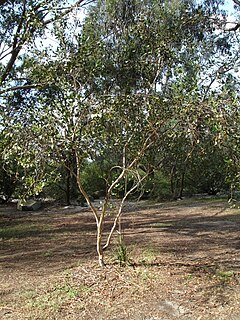
Eucalyptus platypus, also known as moort or maalok, is a species of mallee or marlock that is endemic to the southwest of Western Australia. It has smooth bark, broadly elliptical to more or less round adult leaves, flower buds in groups of nine on a broad, flattened peduncle, usually creamy white flowers and conical, down-turned fruit.
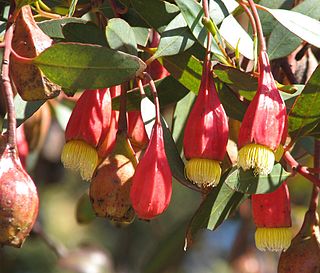
Eucalyptus forrestiana, commonly known as fuchsia gum or fuchsia mallee, is a species of small tree or mallet and is endemic to an area near Esperance, Western Australia. It has smooth grey bark, narrow oblong to lance-shaped adult leaves, flower buds that are square in cross-section, red at maturity and arranged singly in leaf axils, yellow flowers and four-angled, winged fruit.

Eucalyptus woodwardii, commonly known as lemon-flowered gum and also Woodward's blackbutt, is a small tree or mallee that is endemic to Western Australia. The Noongar name for the tree is Gungurra.
A marlock or moort is a shrubby or small-tree form of Eucalyptus found in Western Australia. Unlike the mallee, it is single-stemmed and lacks a lignotuber. It has a dense canopy of leaves which often extends to near ground level.

Eucalyptus langleyi, commonly known as the green mallee ash or albatross mallee, is a species of mallee that is endemic to a small area of New South Wales. It has mostly smooth grey to yellowish bark, lance-shaped to curved adult leaves, flower buds in groups of seven, white flowers and cup-shaped to barrel-shaped fruit.

Eucalyptus megacornuta, also known as warted yate or warty yate, is a species of Eucalyptus that is endemic to the south-west of Western Australia.

Eucalyptus nandewarica, commonly known as mallee red gum, is a species of tree or mallee that is endemic to a small area of western New South Wales. It has mostly smooth bark, lance-shaped adult leaves, flower buds in groups of three or seven, white flowers and cup-shaped or hemispherical fruit.
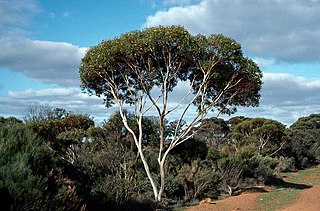
Eucalyptus albida, commonly known as the white-leaved mallee, is a mallee that is endemic to the south-west of Western Australia. It has smooth white or greyish brown bark, lance shaped adult leaves, and flowers in groups of between seven and eleven. The flowers are creamy white and the fruit are hemispherical to cone-shaped. The juvenile leaves that are often retained on mature plants are arranged in opposite pairs, egg-shaped to heart-shaped and bluish grey.
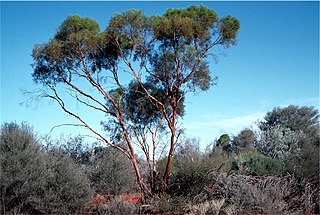
Eucalyptus formanii, commonly known as Die Hardy mallee, Forman's mallee, or feather gum, is a species of tree or mallee that is endemic to Western Australia. It has rough bark over most, or all of its trunk, smooth bark above, linear adult leaves, flower buds in groups of seven or nine, creamy white flowers and cup-shaped to hemispherical fruit.

Eucalyptus griffithsii, commonly known as Griffith's grey gum, is a species of mallee or tree that is endemic to Western Australia. It has smooth grey to whitish bark, sometimes with rough, loose fibrous bark near the base of the trunk, lance-shaped adult leaves, flower buds in groups of three, white flowers and conical to cup-shaped fruit.

Eucalyptus kingsmillii is a mallee that is native to the arid central areas of Western Australia and South Australia.

Eucalyptus merrickiae, commonly known as goblet mallee, is a species of mallee that is endemic to a small area on the south coast of Western Australia. It has rough, flaky bark on part or all of the trunk, sometimes on the base of the larger branches, linear adult leaves, flower buds in groups of three, creamy white flowers and cylindrical fruit.
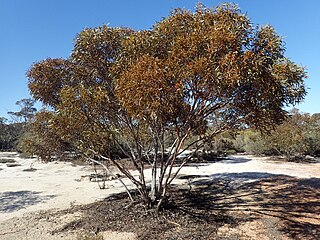
Eucalyptus pileata, commonly known as the capped mallee, is a species of mallee that is native to South Australia and Western Australia. It has smooth greyish bark, narrow lance-shaped adult leaves, flower buds in groups of seven, white flowers and cup-shaped, conical or barrel-shaped fruit.

Eucalyptus sepulcralis, commonly known as weeping gum or weeping mallee, is a mallee that is endemic to a small area along the southern coast of Western Australia. It has slender stems with smooth bark, narrow elliptical to narrow lance-shaped leaves, flower buds in groups of seven, pale yellow flowers and barrel-shaped to urn-shaped fruit.

Eucalyptus annulata, commonly known as the open-fruited mallee, is a mallee that is native to Western Australia.

Eucalyptus ceracea also known as the Seppelt Range gum or Seppelt Range yellow-jacket, is a species of small tree or mallee that is endemic to a small area in the north of Western Australia. It has thick, fibrous or flaky bark on the trunk and larger branches, dull, glaucous, egg-shaped leaves arranged in opposite pairs, flower buds in groups of seven or nine, bright orange flowers and urn-shaped fruit. The leaves, buds and fruit are covered with a white wax.

Eucalyptus desmondensis, commonly known as Desmond mallee, is a species of slender mallee that is endemic to a small area in the south-west of Western Australia. It has smooth bark, lance-shaped adult leaves, flower buds in groups of between nine and nineteen, cream-coloured to pale yellow flowers and cup-shaped to barrel-shaped fruit.

Eucalyptus dielsii, commonly known as the cap-fruited mallee or cap-fruited mallet is a species of mallet that is endemic to the south-west of Western Australia. It has smooth bark, lance-shaped adult leaves, flower buds in groups of seven, yellow to yellowish green flowers and cylindrical to hemispherical fruit with a flange near the rim.





















